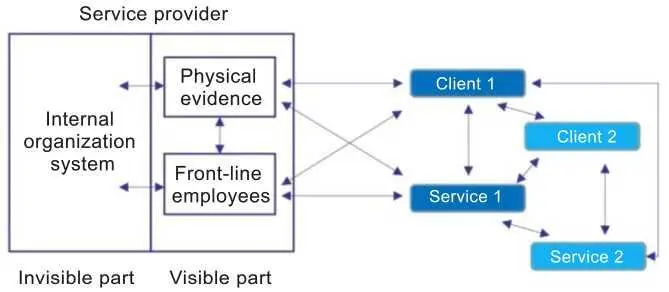2.2.1. The organizational angle: the concept of servuction
Servuction 8is one of the founding models in service management and remains an essential reference for understanding the reality and challenges of service at both a marketing and managerial level. This neologism, formed from the terms service and production, indicates the production system of a service. The model identifies the key elements necessary to produce a service and highlights the major role of the customer and the resulting managerial implications. The servuction model is shown in Figure 2.1.
2.2.1.1. Elements necessary for the production of the service
Five main elements make up the servuction model:
– the front-line employees in contact with the customer; these employees may disappear in automated or digitalized services; however, they remain essential in most service situations, if only to relay a failure of the technical system;
– the physical evidence is made up of all the material elements necessary for the production of the service and which can be used by the customer, by the front-line employees or by both at the same time;
– the internal organization system is the part that is not visible to the customer; often called the back office; it supports the front office, which is the part visible to the customer;
– the customer who, unlike the production model, is present in the service production model, participates in the production of the service;
– the service is the goal of the system, the result of the interaction between all the elements.

Figure 2.1. Servuction (Eiglier 2004, p. 15). For a color version of this figure, see www.iste.co.uk/mathieu/services.zip
2.2.1.2. Co-production of the service
The notion of co-production is an essential specificity of service management. It indicates that the service cannot be produced by the service provider alone but that it is co-produced with the client. Co-production not only signals the clients’ participation in the production of the service but also seals the necessity of their presence in the production of the service. The notion of co-production is linked to that of customer participation, which underlines the role that the customer must play in the process in order to obtain the service he or she wants. Servuction being a system, if we remove one element, the client in particular, the system will no longer function. This property of systems demonstrates the necessary presence of the client in the production of the service; without the client, there can be no service.
The customer is, thus, the central issue in service management. Not only must customers be satisfied as clients, but they must also be integrated as co-producers. The service provider must not only meet their expectations to satisfy them but also manage their participation to ensure that his or her service production system works as well as possible. The fourth part of this book returns to this point in depth.
2.2.1.3. The B2B manager facing servuction
To be fully relevant in the B2B context, servuction must integrate two specificities. The first one is a stretching of its temporality; B2B servuction starts well before the production of the service and extends downstream with the maintenance of a relationship within which a next business opportunity can germinate. The second specificity of B2B servuction is an inversion of its spatiality; much more than a client going to the service provider, it is often the service provider who goes to the client.
The temporal specificity of B2B servuction refers to the reality of a service relationship that takes place over a long period of time. In B2B, servuction will often be the result of a first stage of interaction between the service provider and the client, that starts with a contact, then moves towards a purchasing and negotiation process 9. In this stage upstream of the usually described servuction, the provider and the client take the time to get to know each other and define, specify or clarify, both the service and the servuction. It is not uncommon, for example, for the client to ask the service provider for the intervention of particular collaborators, thereby influencing the operating mode of the service. On the other hand, the duration of B2B relationships contributes to stretching out the servuction over time, which then tends to evolve and change. Contracts are signed over several years, even over 10 years, 20 years and sometimes even more. This long time span requires adaptations of the servuction.
In the original model, the servuction takes place in the physical location of the service, which is the place where the company welcomes the customer in order to perform the service (the post office, the supermarket, the hotel, etc.). In most B2B services, it is the service provider who moves to the customer’s premises, and the service is no longer performed entirely at the service provider’s premises. This is the spatial specificity of B2B services.
The manager is responsible for his or her servuction. His or her performance will be directly linked to the performance of the servuction for which he or she is responsible. The performance of the servuction is inexorably linked to the long-term maintenance of customer satisfaction, the involvement of the front-line employees and the excellence of the service. Three key competencies will enable him or her to achieve this goal: marketing skills to satisfy the customer, leadership skills to involve his or her team and technical and organizational skills to maintain service excellence. It is undoubtedly a real managerial challenge to develop and maintain these three skills concurrently. Usually, marketing skills are in the hands of marketers and technical and organizational skills are in the hands of engineers, technicians and operational managers. Customer orientation is, therefore, an essential skill for managers to meet this challenge.
Two main profiles are found in B2B services:
– managers who owe their position to a track record of technical and operational excellence. These managers may lack marketing and leadership skills. These profiles are found particularly in technical, scientific and engineering departments;
– managers who have less technical and more generalist backgrounds or training and who, therefore, have more natural marketing and leadership skills, but who may lack technical and operational confidence in tricky situations or when dealing with customers and teams who are more experienced in these areas.
These weaknesses can obviously be worked on. It is essential for the manager to be aware of them by identifying them after an introspection or with the help of HR diagnostic tools such as 360 degrees. These weaknesses can then be addressed through training and also through mentoring and internal coaching.
2.2.2. The market angle: a process and an outcome
If servuction defines service from an internal organizational perspective, the customer will have a different approach to service.
2.2.2.1. Letting the client speak
To find out how the client perceives and defines the service, the easiest way is to ask the client simple questions about their perception and evaluation of the service. When letting customers express themselves in this way, one will see that they have a vision that at first glance seems disjointed, mixing what is incidental and what is essential in the eyes of the provider.
Читать дальше


![Matthew Vincent - [you] Ruined It for Everyone!](/books/216429/matthew-vincent-you-ruined-it-for-everyone-thumb.webp)










